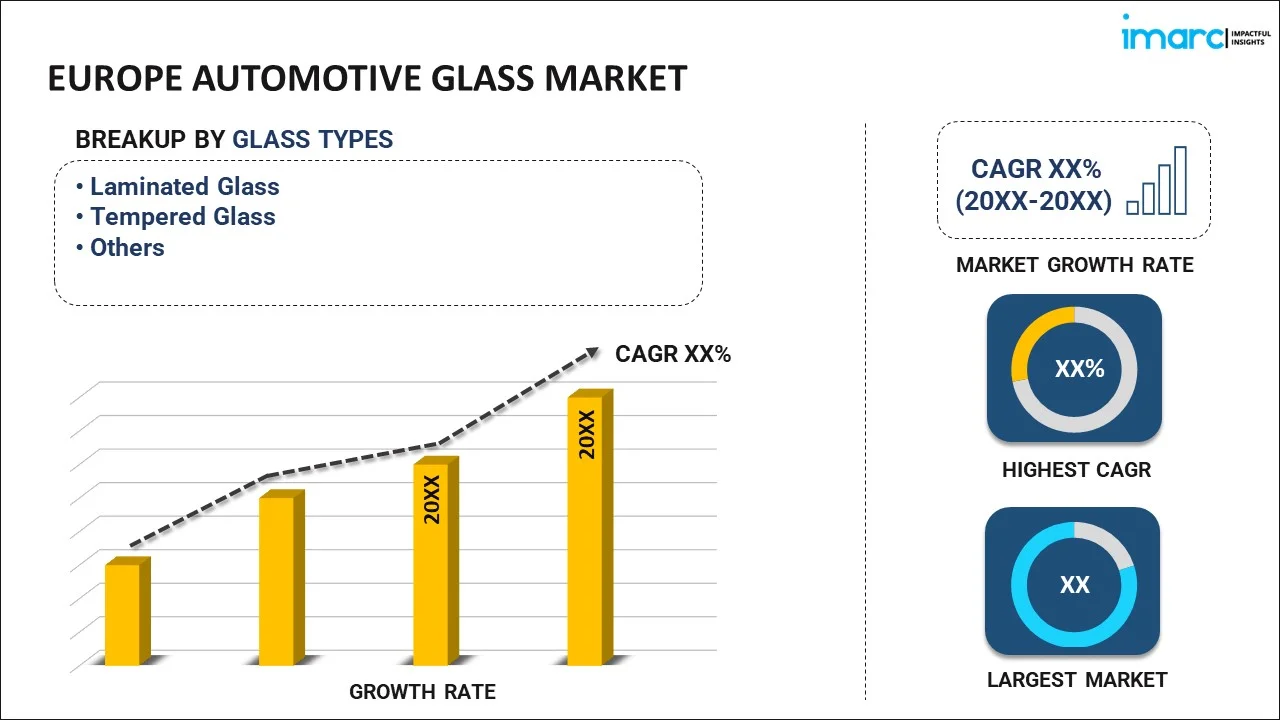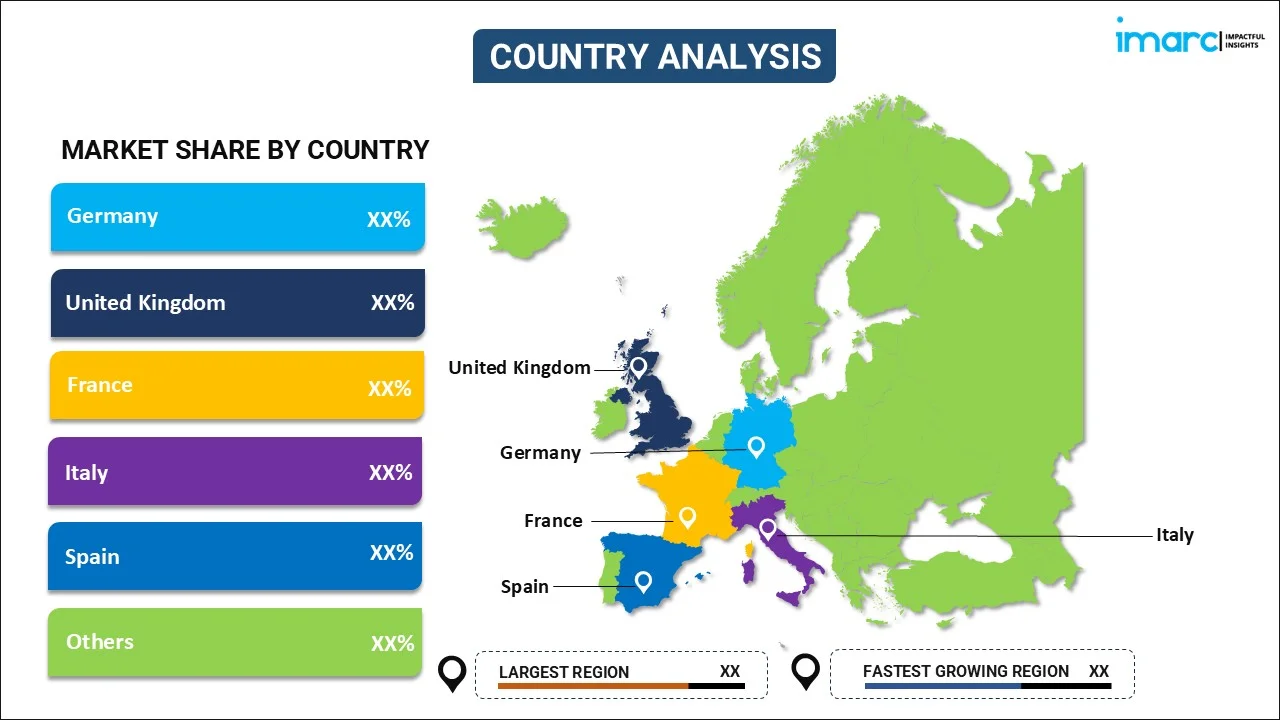
Europe Automotive Glass Market Report by Glass Type (Laminated Glass, Tempered Glass, and Others), Material Type (IR PVB, Metal Coated Glass, Tinted Glass, and Others), Vehicle Type (Passenger Cars, Light Commercial Vehicles, Trucks, Buses, and Others), Application (Windshield, Sidelite, Backlite, Rear Quarter Glass, Sideview Mirror, Rearview Mirror, and Others), End User (OEMs, Aftermarket Suppliers), Technology (Active Smart Glass, Passive Glass), and Country 2025-2033
Market Overview:
The Europe automotive glass market size reached USD 15.9 Billion in 2024. Looking forward, IMARC Group expects the market to reach USD 22.5 Billion by 2033, exhibiting a growth rate (CAGR) of 3.73% during 2025-2033.
|
Report Attribute
|
Key Statistics
|
|---|---|
|
Base Year
|
2024
|
|
Forecast Years
|
2025-2033
|
|
Historical Years
|
2019-2024
|
|
Market Size in 2024
|
USD 15.9 Billion |
|
Market Forecast in 2033
|
USD 22.5 Billion |
| Market Growth Rate 2025-2033 | 3.73% |
Automotive glass is commonly used to produce windshields and windows of vehicles. It is water-resistant and assists in preventing the car from dirt, dust, wind and ultraviolet (UV) rays. Consequently, it finds extensive applications in the automotive industry in Europe.
The rising sales of automobiles represent one of the significant factors driving the automotive glass market in Europe. Moreover, the European Commission has proposed stringent regulations for reducing carbon emissions. This has resulted in the emergence of lightweight and fuel-efficient vehicles, which is escalating the demand for high-grade automotive glass in the region. Apart from this, the increasing popularity of autonomous and hybrid vehicles, along with the emerging electric automobile glass, which is equipped with cameras and sensors, is propelling the market growth. Furthermore, leading manufacturers are focusing on the introduction of colored coatings, deterring smash-and-dash burglary, protection against glare, providing acoustic comfort and safeguarding the passengers from ejection in a collision. However, the sudden outbreak of coronavirus disease (COVID-19) and the lockdown restrictions imposed in various parts have disrupted the production of automotive glass in Europe. The market will experience growth once lockdown restrictions are uplifted.
Key Market Segmentation:
IMARC Group provides an analysis of the key trends in each segment of the Europe automotive glass market report, along with forecasts at the regional and country levels from 2025-2033. Our report has categorized the market based on glass type, material type, vehicle type, application, end user and technology.
Breakup by Glass Type:

- Laminated Glass
- Tempered Glass
- Others
Breakup by Material Type:
- IR PVB
- Metal Coated Glass
- Tinted Glass
- Others
Breakup by Vehicle Type:
- Passenger Cars
- Light Commercial Vehicles
- Trucks
- Buses
- Others
Breakup by Application:
- Windshield
- Sidelite
- Backlite
- Rear Quarter Glass
- Sideview Mirror
- Rearview Mirror
- Others
Breakup by End User:
- OEMs
- Aftermarket Suppliers
Breakup by Technology:
- Active Smart Glass
- Suspended Particle Glass
- Electrochromic Glass
- Liquid Crystal Glass
- Passive Glass
- Thermochromic
- Photochromic
Breakup by Country:

- Germany
- France
- United Kingdom
- Italy
- Spain
- Others
Competitive Landscape:
The competitive landscape of the industry has also been examined along with the profiles of the key players.
Report Coverage:
| Report Features | Details |
|---|---|
| Base Year of the Analysis | 2024 |
| Historical Period | 2019-2024 |
| Forecast Period | 2025-2033 |
| Units | Billion USD |
|
Scope of the Report
|
Exploration of Historical and Forecast Trends, Industry Catalysts and Challenges, Segment-Wise Historical and Predictive Market Assessment:
|
| Glass Types Covered | Laminated Glass, Tempered Glass, Others |
| Material Types Covered | IR PVB, Metal Coated Glass, Tinted Glass, Others |
| Vehicle Types Covered | Passenger Cars, Light Commercial Vehicles, Trucks, Buses, Others |
| Applications Covered | Windshield, Sidelite, Backlite, Rear Quarter Glass, Sideview Mirror, Rearview Mirror, Others |
| End Users Covered | OEMs, Aftermarket Suppliers |
| Technologies Covered | Active Smart Glass: Suspended Particle Glass, Electrochromic Glass, Liquid Crystal Glass Passive Glass: Thermochromic, Photochromic |
| Countries Covered | Germany, France, United Kingdom, Italy, Spain, Others |
| Customization Scope | 10% Free Customization |
| Post-Sale Analyst Support | 10-12 Weeks |
| Delivery Format | PDF and Excel through Email (We can also provide the editable version of the report in PPT/Word format on special request) |
Key Questions Answered in This Report:
- How has the Europe automotive glass market performed so far and how will it perform in the coming years?
- What has been the impact of COVID-19 on the Europe automotive glass market?
- What are the key regional markets?
- What is the breakup of the market based on the glass type?
- What is the breakup of the market based on the material type?
- What is the breakup of the market based on the vehicles type?
- What is the breakup of the market based on the application?
- What is the breakup of the market based on the end user?
- What is the breakup of the market based on the technology?
- What are the various stages in the value chain of the industry?
- What are the key driving factors and challenges in the industry?
- What is the structure of the Europe automotive glass market and who are the key players?
- What is the degree of competition in the industry?
Need more help?
- Speak to our experienced analysts for insights on the current market scenarios.
- Include additional segments and countries to customize the report as per your requirement.
- Gain an unparalleled competitive advantage in your domain by understanding how to utilize the report and positively impacting your operations and revenue.
- For further assistance, please connect with our analysts.
 Inquire Before Buying
Inquire Before Buying
 Speak to an Analyst
Speak to an Analyst
 Request Brochure
Request Brochure
 Request Customization
Request Customization




.webp)




.webp)












